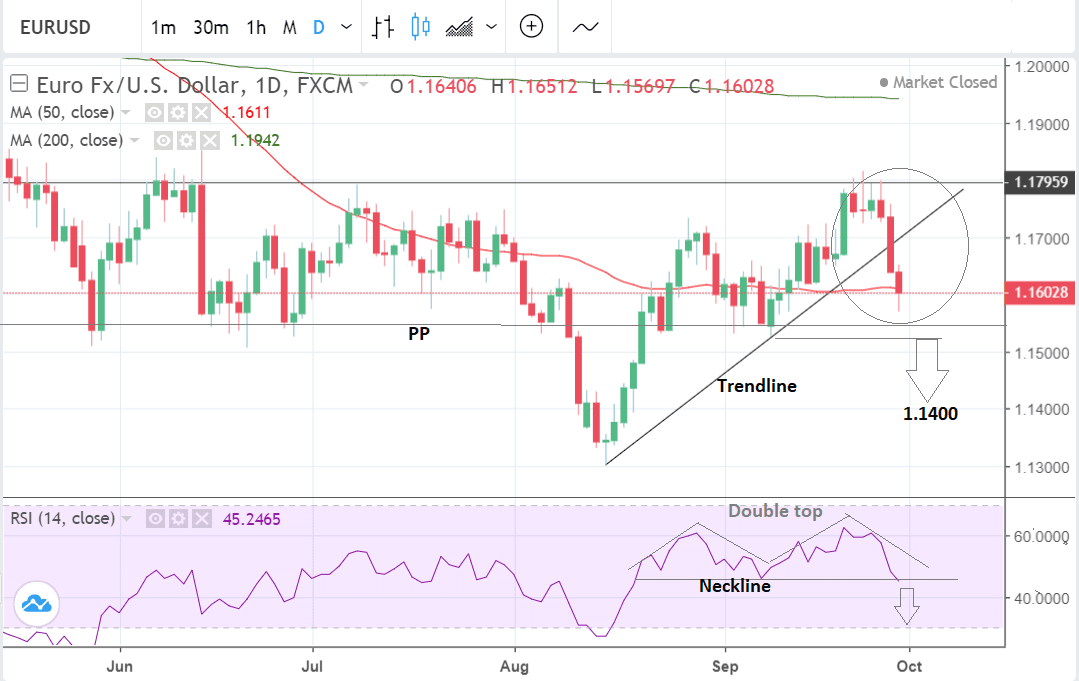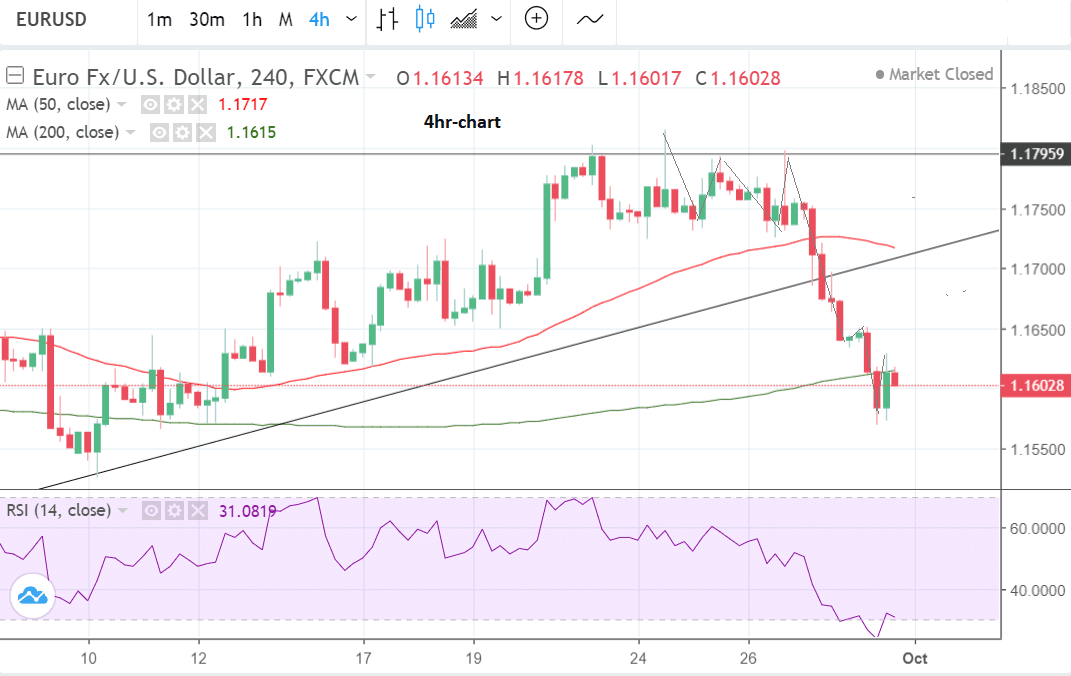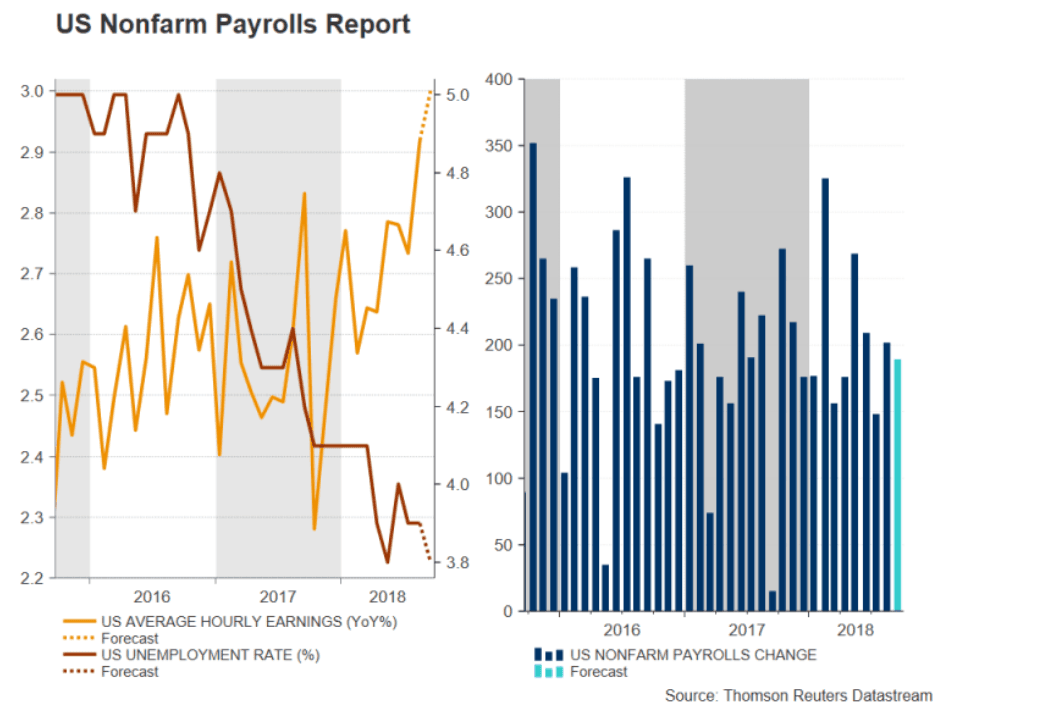Euro-to-Dollar Forecast: Chart Looking Increasingly Bearish

Image © European Central Bank
- EUR/USD's short-term downtrend turns negative
- Support from moving average and pivot likely
- Main release for Dollar and Euro are labour market data
The Euro-to-Dollar exchange rate has declined mainly as a result of weakness for the Euro due to a combination of concerns about the Italian economy and fading inflation pressures, possibly signalling a slow down in broader growth in the Euro-area.
The Dollar has meanwhile risen exacerbating EUR/USD's downtrend, after the Federal Reserve changed the language of its policy guidance to suggest the economy could 'stand on its own feet' and did not now need further stimulus or "accommodation".
After pushing up to touch the key 1.1800 highs as it had done on several previous occasions, the pair failed to break higher and fell, instead, to end the week trading at 1.1603.
During its two-cent decline, it broke below the trendline drawn from the August lows and this was a major bearish turn of events for the pair indicating the short-term trend had probably changed from 'up' to 'down'.
The peaks and troughs on the 4hr chart also showed a sequence of lower highs and lower lows further suggesting a new downtrend had begun.
EUR/USD continued to fall until it reached support at the 50-day moving average (MA) where it stalled and recovered marginally but still ended the week on a negative note.
Further support emanates from the monthly pivot (PP) situated not far below Friday's lows, and is likely to place a floor under the exchange rate. As its name suggests, the pivot is a level where prices are prone to rotating and moving in the opposite direction, so there is a risk the downtrend could 'pivot' at 1.1358 and move higher.
Ideally, we would, therefore, like to see the exchange rate break clearly below the PP before forecasting a continuation lower. A break below the 1.1525 September 10 lows would supply that confirmation and give the green-light to a continuation down to a target at 1.1400.
The RSI momentum indicator also looks bearishly poised to break lower after forming what looks like a double top pattern and touching the neckline at the intervening low. A break below the neckline would signal an acceleration in downside momentum which would compliment the bearish outlook we have for the exchange rate and reinforces the negative forecast.
Advertisement
Get up to 5% more foreign exchange for international payments by using a specialist provider to get closer to the real market rate and avoid the gaping spreads charged by your bank when providing currency. Learn more here
The Euro: What to Watch this Week
The main release for the Euro in the week ahead is data showing the unemployment rate, which is forecast to remain unchanged at 8.2%, when it is released at 10.00 B.S.T on Monday, October 1.
Eurozone retail sales is forecast to show a 0.2% rise compared to the previous month when it is released at 10.00, on Wednesday, and a 1.1% increase compared to the 1.6% of the previous year.
Investors are likely to pay a lot of attention to data after disappointing data out last week showed core inflation slow to 0.9% compared to 1.1% previously, which was well below the authorities' target of just under 2.0%.
Part of the decline was due to lower consumer demand which is likely to be reflected in releases such as retails sales and unemployment.
There is a risk these could push the Euro even lower if they undershoot expectations.
The same goes for Eurozone manufacturing and services sector PMI revisions for September which are released on Wednesday at 9.00.
The Dollar: What to Watch this Week
The main release for the Dollar in the week ahead is the release of labour market data with markets likely to focus on average earnings in particular.
Wage dynamics will likely have a steer on the outlook for monetary policy at the U.S. Federal Reserve which in turn is one of the main drivers of the Dollar.
Higher wages can drive up interest rates and higher interest rates tend to push up the value of the Dollar.
The consensus forecast amongst leading economists is that wages will rise by 3.0% in September, which would be the fastest rise in nine years.
If this comes to pass the Dollar could gain a boost from the release.
"The U.S. economy is forecast to have added 188k jobs in September, somewhat less than the 201k gains seen in the prior month. The jobless rate is expected to inch lower by 0.1 percentage points to 3.8%, signaling a further tightening in the labour market and this will likely be evident in the monthly wage numbers. Average hourly earnings are projected to have risen by 3.0% year-on-year in September, which would mark the fastest rate in nine years," says a preview from brokers XM.com.
If the Dollar is not moved by wage or employment figures it may be by commentary from Fed officials such as fed chair Jerome Powell, who is speaking on Wednesday at 17.00 B.S.T.
Markets will be looking for clarification on whether the chairman continues to retain his marginally hawkish stance as shown at the Fed's meeting last week. It is probable he will given the short period time since the FOMC.
ISM Manufacturing data is expected to show a fall to 60.3 from 61.3 previously when it is released at 15.00 B.S.T. on Monday. The ISM is one of the most important gauges of manufacturing in the US and reached a 14-year high in August so some sort of a pullback is possible.
"We expect to see a modest pullback in August, with the index slipping to 60.0. The latest regional Fed purchasing managers’ indices point to some moderation, with the averages for new orders, production and employment having come down in recent months. More generally, such elevated readings are not usually sustainable in a strong-dollar environment," say Wells Fargo in a week ahead analysis.
ISM Non-Manufacturing is forecast to fall to 58.1 from 58.5 when it is released at 15.00 B.S.T. on Wednesday and is also an important economic gauge.
Advertisement
Get up to 5% more foreign exchange for international payments by using a specialist provider to get closer to the real market rate and avoid the gaping spreads charged by your bank when providing currency. Learn more here







